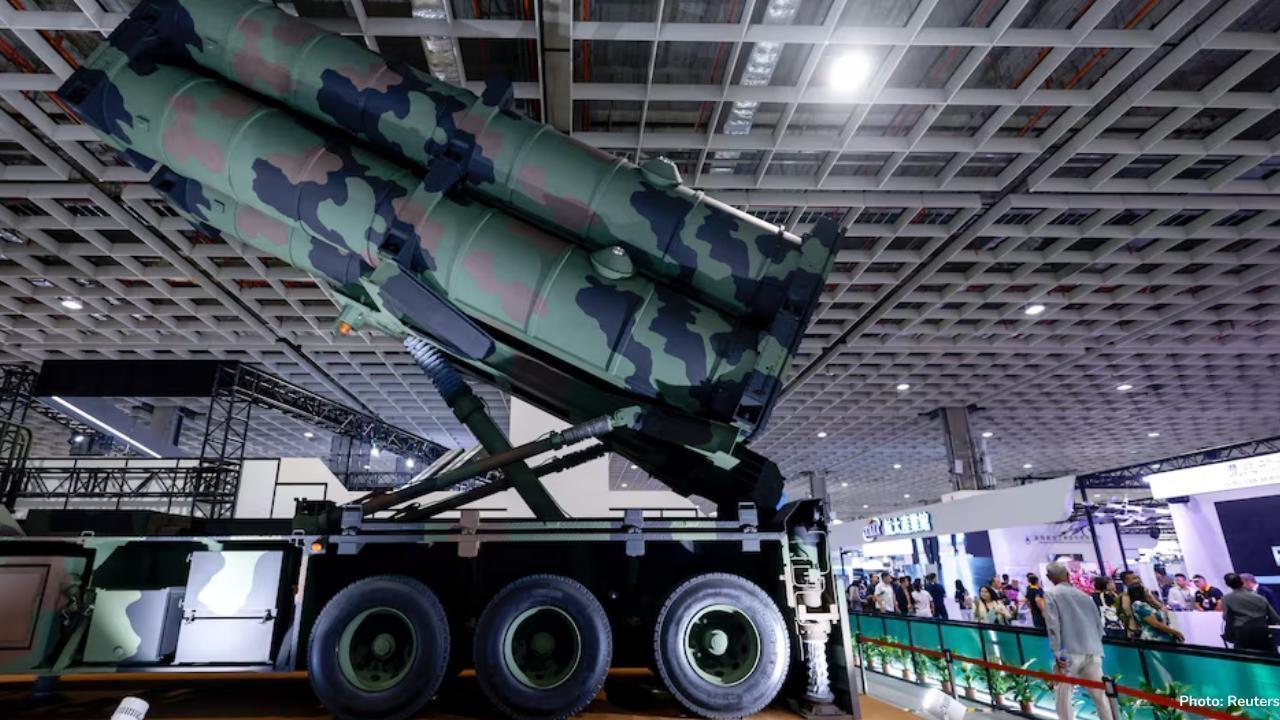
Post by : Monika
Taiwan is working on a new air defense system called the T-Dome. This system is designed to protect the island from missile attacks. The main idea behind T-Dome is to make Taiwan’s defense faster, smarter, and more accurate.
It links the sensors that detect incoming missiles directly to the weapons that destroy them. This kind of connection is called “sensor-to-shooter”. By using this method, Taiwan can react quickly when an attack happens and increase the chances of stopping enemy missiles.
The T-Dome system was introduced by Taiwan’s Vice President, Lai Ching-te, last week. He said the system is an important part of Taiwan’s plan to modernize its military.
The goal is to make Taiwan strong enough to defend itself, even though China has more soldiers and bigger military equipment. China considers Taiwan as part of its territory. Over the years, it has tried to pressure Taiwan using military exercises and political actions. This makes Taiwan’s defense system very important.
Defence Minister Wellington Koo explained that T-Dome will connect several different missile systems. These include U.S.-made Patriot missiles, Taiwan’s own Sky Bow missiles, Stinger missiles for targets flying at low heights, and the new Chiang-Kong missiles for high-flying targets. By connecting all these weapons, Taiwan can shoot down enemy missiles more effectively. The system allows multiple missile types to work together, covering different heights and distances.
Koo said that combining weapons, sensors, and radar systems makes Taiwan’s defense much stronger. He explained, “If we connect anti-missile, anti-air, and anti-drone systems, our chances of stopping attacks increase. We will focus on weapons that are fast, mobile, and hard to destroy.” This means that T-Dome is not only smart but also designed to survive if the enemy tries to attack it directly. Mobility is important because it allows Taiwan to move the weapons to safer locations when necessary.
The government is planning to ask the legislature for a special budget by the end of this year to buy new equipment for T-Dome. This budget will cover advanced missiles, radars, and communication systems.
It will also include funding for research to improve the T-Dome system in the future. By making these investments, Taiwan aims to increase its defense capabilities without relying solely on its size or the number of soldiers.
Taiwan has been working on ways to strengthen its defense strategy even though China has a much larger military. Instead of competing directly with China’s numbers, Taiwan is focusing on smart defense technology.
\This includes missiles, sensors, radars, and communication systems that work together. The goal is to stop enemy attacks quickly and accurately. By investing in high-tech defense, Taiwan can protect its people and territory more efficiently.
President Lai has promised to raise Taiwan’s defense spending to 5% of the country’s economy by 2030. This is a big increase compared to the current budget. He explained that the money will help Taiwan build new weapons, upgrade existing systems, and train soldiers to use advanced technology. The T-Dome system is a part of this long-term plan.
China has been developing new military weapons like stealth fighter jets, aircraft carriers, and long-range missiles. These weapons could pose a serious threat to Taiwan if the island does not strengthen its defenses.
At the same time, China is facing challenges such as corruption within its military and rising costs for its weapons programs. Taiwan hopes that by building smart systems like T-Dome, it can defend itself even against a bigger military power.
The T-Dome system is designed to work very fast. When a missile is detected, the sensors immediately send information to the control center. The control center then decides which weapon to use. This process happens in seconds. By making the system faster, Taiwan increases the chances of shooting down enemy missiles before they reach their targets.
T-Dome also uses advanced software that can calculate the path of enemy missiles. This software helps predict where the missile will go and what weapon should be fired to stop it. By using computers to calculate these paths, Taiwan can respond more accurately than relying only on human operators. This makes the system smarter and more reliable.
Another advantage of T-Dome is that it can link multiple missile batteries. This means that different missile systems can work together at the same time. For example, if a missile is flying very high, Chiang-Kong missiles can be used. If another missile is flying low, Stinger missiles can be fired. By coordinating all the weapons, Taiwan can cover all angles of attack. This reduces the risk of missing incoming missiles.
The Taiwanese military also plans to use mobile launchers. This allows missiles to be moved quickly if there is a threat. Mobility makes it harder for an enemy to target and destroy the missile systems. It also allows Taiwan to protect different parts of the island depending on the situation.
T-Dome is not only a defensive system. It also sends a strong message to China. It shows that Taiwan is serious about protecting itself and is investing in technology to make its defense more effective. This may make China think twice before taking aggressive action against Taiwan.
The development of T-Dome is part of a bigger trend. Many countries around the world are investing in integrated air defense systems. These systems link sensors, radars, and weapons together to increase efficiency. Taiwan’s T-Dome is an example of how a smaller country can use technology to defend itself against larger powers.
Experts in Taiwan say that T-Dome could increase the success rate of intercepting missiles by a significant margin. This means that more incoming missiles could be destroyed before causing damage. The system is designed to handle multiple attacks at the same time, which is important if there are many missiles fired in a short period.
In addition to defending against missiles, T-Dome can also be used to protect Taiwan from drones or aircraft. Modern warfare is not only about missiles. Drones and airplanes can also be dangerous. By linking multiple weapons and sensors, T-Dome can respond to different types of threats.
The Taiwanese government believes that investing in T-Dome and other smart weapons will help maintain peace in the region. By showing that Taiwan can defend itself, the island hopes to prevent conflict. T-Dome is not meant to start a war; it is meant to stop one if it happens.
Taiwan’s T-Dome system is a modern, fast, and smart air defense system. It links sensors directly to weapons, making it possible to respond quickly to threats. By combining different missile types, using mobile launchers, and applying advanced software, Taiwan can protect its people and territory from missile attacks. The system also sends a clear message that Taiwan is prepared to defend itself and will continue to invest in modern military technology. With T-Dome, Taiwan is taking a big step forward in ensuring the safety of its citizens and maintaining peace in a tense region.










OpenAI Highlights Growing Cybersecurity Threats from Emerging AI Technologies
OpenAI has raised alarms about the increasing cyber risks from its upcoming AI models, emphasizing s

Manchester City Triumphs 2-1 Against Real Madrid, Alonso Faces Increased Scrutiny
Manchester City secured a 2-1 victory over Real Madrid, raising concerns for coach Xabi Alonso amid

Cristiano Ronaldo Leads Al Nassr to 4-2 Victory Over Al Wahda in Friendly Face-Off
Ronaldo's goal helped Al Nassr secure a 4-2 friendly win over Al Wahda, boosting anticipation for th

Landon Donovan Challenges Australia Coach on World Cup Prospects
Landon Donovan counters Australia coach Tony Popovic’s optimism for the World Cup, expecting an earl

Mercedes-Benz Forms Landmark Partnership with WTA
Mercedes-Benz and the WTA unveil a significant partnership effective January 2026, with major invest

Abhishek Addresses Divorce Rumours Concerning His Family
Abhishek Bachchan confirms that daughter Aaradhya remains oblivious to divorce speculations, focusin